Wednesday, March 31. 2010
Why Greenpeace is Wrong about IT
Via WorldChanging
-----
by Alex Steffen
The cloud is growing at a time when climate change and reducing emissions from energy use is of paramount concern. With the growth of the cloud, however, comes an increasing demand for energy. For all of this content to be delivered to us in real time, virtual mountains of video, pictures and other data must be stored somewhere and be available for almost instantaneous access. That ‘somewhere’ is data centres - massive storage facilities that consume incredible amounts of energy.
Sounds scary, right?
Except when you actually look up the numbers. Computing accounts for a bit less than 3% of U.S. energy usage, according to Lawrence Livermore Labs. The global IT industry as a whole generates about 2% of global CO2 emissions.
Cars, on the other hand, which the vast majority of the people Greenpeace is trying to target also own, are the single largest contributor to climate change, according to NASA, exceeding all other sources in their impacts, and exceeding computing's global impacts by more than a factor of ten. Greenpeace (I'm a supporter) has made a lot of noise about computing's climate impacts, while the average commute or drive to the mall is likely far, far more a threat to the future than the average month's Google searching.
In fact, in some cases, that Google search can replace that trip to work or the mall. Technology can in fact greatly increase the efficiency of urban living, particularly car-free living in walkable neighborhoods as I wrote yesterday. Indeed, the same study Greenpeace is relying on finds that tech has as much capacity to cure as harm: "The Smart 2020 study also made a compelling case for ICT’s significant potential to deliver climate and energy solutions, estimating that ICT technologies could cut 7.8 GtCO2 of global greenhouse gas emissions by 2020, a 15% reduction over business-as-usual projections."
It may pull hits to call the iPad a planet killer, but worrying about the right thing is generally a good caution. If Greenpeace really wants to get up in people's grill about something that needs to change, it should start with their cars.
PS: I'm a supporter of Greenpeace. And yes, they've mentioned cars in the past. That said, the fact the word "car" doesn't even appear on Greenpeace USA's front page is telling.
UPDATE: Quick note. Just got into a bit of conversation about Greenpeace's talking point on this, that "if it were considered a country, our collective computing carbon footprint would place 5th in world for energy use." I think it's misleading, almost to the point of dishonesty.
Parse the statement:
1) if it were a country -- immediately, in order to be a fair comparison, we'd have to know something about the ranking of national emissions, which, as it turns out, is quite different than the structure of emissions sources, so immediately we're into an apples and oranges comparison, if for no other reason that there are 212 nations, but only a small number of categories emissions sources.
2) our collective -- intentionally vague, perhaps, but for this talking point to be even vaguely true, it has to mean "global" which sounds less out of whack.
3) 5th in the world for energy use -- I still don't see how that number stacks up, but even granting its correctness, there are two problems: a) 5th in the world naturally makes people draw the association that it's the 5th biggest source of CO2, and b) "for energy use" is a completely arbitrary line, drawn apparently just to make computers seem a bigger part of the problem.
To be clear, emissions from dirty energy use in ICT manufacture/use is roughly the same magnitude of problem as emissions from cement manufacturing, or air travel, or landfill methane, or coal fires and gas flares. It's a problem, one we should fix, but this campaign makes it seem like it ought to be one of our top priorities, rather than way down the list after dealing with massive society-wide problems like transportation/land use, buildings, forestry and agriculture.
It all goes back to the point I made earlier about Comparative Measurements and Knowing Our Facts, that clarity counts, and intentionally muddying the waters to score the most temporary of small victories (if even that) is bad strategy and ultimately counter-productive.
C'mon, Greenpeace: you're better than this!
Monday, March 29. 2010
Beijing to Shoot Giant Deodorant Guns at Smelly Landfills

One solution would be aggressive waste reduction policies but where is the fun in that. Let's do it Schwarzenegger-style and fire a cannon at it!
Yup, the city of Beijing is installing 100 giant deodorant guns at its Asuwei dump site to address complaints it has received about the smell. Along with the cannons, the city will cover the trash with plastic to help reduce the smell. Protests by local residents have already sprung up as they have to put up with the stench
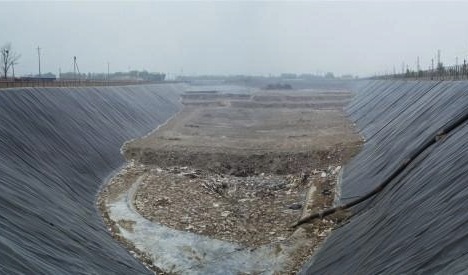
Yong He Zhuang Garbage Landfill Site photographed by Wang Jiuliang
The high-pressure cannons can spray gallons of fragrance per minute with a range of up to 20 feet. But it seems like Beijing is missing the target, pun intended. The city's waste problem is growing at about 8-percent every year. And Lady Speedstick ain't going to cut it.
"All landfill and treatment sites in Beijing will be full in four years. That's how long it takes to build a treatment plant. So we need to act right now to resolve the issue," said Wang Weiping, a waste expert in the city government. "It's necessary to restructure the current disposal system. We cannot rely on landfill anymore. It's a waste of space."
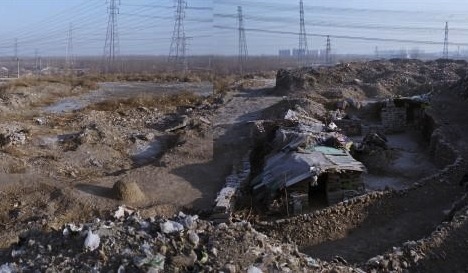
Yongshun County photographed by Wang Jiuliang
Less than 4-percent of Beijing's trash is recycled, 2-percent of it is burned but the rest just ends up in landfills. That's alarming considering places like the US and UK recycle about 35-percent of their trash.
While China has become a consumer society in the past 10 years, the lack of options perpetuate the problem. There are about 200 illegal dump sites around Beijing due to the lack of options. According to the government, 20 million tons of waste went unhanded in 2008. Photographer Wang Jiuliang calls it Beijing's Seventh Ring. He has spent the last year recording and plotting the wastelands using GPS and Google Earth.
"People are forced to use these places for dumps and landfills. There is no better place," he says
Monday, March 15. 2010
Scientists Say They've Found the Most Efficient Way Yet to Turn Carbon Dioxide Back into Fuel
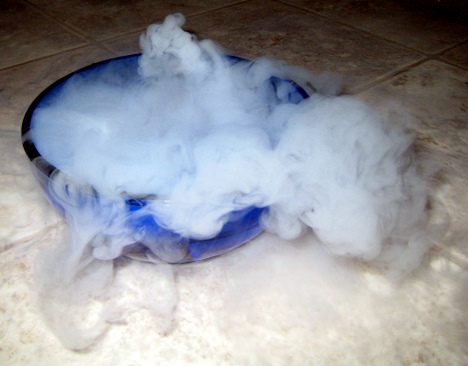
Credit: Mr. Thomas via Flickr.
Scientists say too much carbon dioxide is bad for the Earth. And too much carbon monoxide can kill you. So why are researchers at the University of Michigan excited about turning CO2 into CO? Because the end product could come in handy for producing electricity and hydrogen. U of M chemists, along with others from the University of Oxford, say they've come up with an efficient way to turn carbon dioxide into carbon monoxide using visible light (like sunlight).
Apparently, they're not the first ones to cite the opportunities this creates. Researchers at Sandia National Laboratories in New Mexico boasted in late 2007 about using concentrated solar energy to convert CO2 back to CO.
What's different here? The U of M/Oxford method, reported in the Journal of the American Chemical Society, apparently uses considerably less energy input than current methods. And, it's pretty close to what nature does naturally.
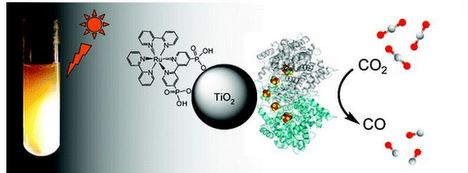
Credit: JACS.
"This is a first step in showing it's possible, and imagine microbes doing something similar," says U of M biological chemist Steve Ragsdale.
"I don't know of any organism that uses light energy to activate carbon dioxide and reduce it to carbon monoxide, but I can imagine either finding an organism that can do it, or genetically engineering one to channel light energy to coax it to do that."
Ragsdale and others used an enzyme-modified titanium oxide and a photosensitizer to make the conversion to carbon monoxide. They say the direct product can be used not only to produce electricity or hydrogen but also can be converted by known catalysts into liquid fuel.
Two things to note: The conversion needs to be done in an oxygen-free environment, and the carbon monoxide that's created needs to be managed (because of the killing people part).
Ragsdale also is a fellow of the Michigan Memorial Phoenix Energy Institute, which develops, coordinates and promotes energy research and education at U of M.
The research was funded by the National Institute of General Medical Sciences.
Is this an answer to the so-called climate crisis of human-induced global warming from the burning of fossil fuels?
According to F.A. Armstrong, from the Oxford Department of Chemistry: "This is a reaction of great technological importance. Otherwise (at synthetic catalysts) the process is so inefficient and slow that it has made little impact on industry."
More from TreeHugger
Fuel Made by Sun, Water, Carbon Dioxide, and Nanotechnology
Where Does all the Carbon Dioxide End Up?
The Silly Season Is Upon Us: Fiorina Goes After Boxer on Climate Action
-----
Via TreeHugger
Friday, February 19. 2010
With 5 Billion Subscriptions, Mobile Industry Has Emissions On Par With Auto and Aviation Industries

Photo via Marco Gomes
Worldwide, there are 4.6 billion cell phone subscriptions and it's expected to hit 5 billion during this year according to the International Telecommunication Union (ITU). With developing countries leapfrogging from no phone to cell phone - completely skipping the notion of land lines - and with developed countries demanding services like mobile banking and healthcare, it seems that the mobile industry has grown to surprising proportions. And that includes an emission...Read the full story on TreeHugger
-----
Via TreeHugger
Tuesday, January 19. 2010
Event: Designing for Immobility – Amsterdam & on-line, January 21, 20.30 CET
As a prelude to the ElectroSmog festival De Balie in Amsterdam will present a showcase of design proposals, practical projects and design-ideas that should persuade us to start moving less.
With on-line and on-site contributions by among others:
John Thackara, director of Doors of Perception, the international conference and knowledge network which sets new agendas for design, will highlight design projects that try to tackle the question of mobility reduction.
www.doorsofperception.com
Stefan Agamanolis, director of Distance Lab, Dublin, will present the specific focus of his organisation on networking rural and remote area’s. The relevant question for the ElectroSmog festival is whether we can live in a sustainable way in the green and still connect to the rest of the world, culturally and economically?
www.distancelab.org
David van Gent is a managing consultant for IBM on Learning Strategy & Technology, Virtual Worlds, Serious Gaming & Web 2.0. He will talk about and demo the Virtual Offices project of IBM, using open SIM technology (similar to second life):
( See for instance this CNN item )
The Medialab Prado, Madrid will present their recent project “In the Air” (tbc); “a visualisation project which aims to make visible the microscopic and invisible agents of Madrid´s air (gases, particles, pollen, diseases, etc), to see how they perform, react and interact with the rest of the city.
(..) The project proposes a platform for individual and collective awareness and decision making, where the interpretation of results can be used for real time navigation through the city, opportunistic selection of locations according to their air conditions and a base for political action.”
www.intheair.es
Eric Kluitenberg, head of the media department of De Balie and initiator of the ElectroSnog festival, will present the concept behind the festival. Besides exploring the critique of mobility theoretically, ElectroSmog will also address the issue practically. All international presentations in the festival will be realised by means of tele-connections between the different international locations.
www.electrosmogfestival.net
This program will be streamed live on the internet – for details please refer to:
www.debalie.nl/live
datum | Thursday 21 January, 20.30 hrs.
language | Engels
entrance free entree
-----
Via The Mobile City
Personal comment:
Shall we start to move less? This question will be asked (and answered?) during this coming event in Amsterdam. Some names to follow here (like John Thackara).
For my part I would rather say "move more sustainably", "move with purpose(s)" and somethimes "move in a mediated way", mix all those approaches, because I believe mobilty will increase in the future rather than the countrary.
Besides, mobility has brought a lot to the transformation of societes. In good and bad ways of course. Experimenting more with the ones that have some potential (like mixing of cultures while keeping differences or on the other side interbreeding, hybridations, some side of tourism --a tiny part--, creation of abstract and interferential environments and experiences --planes, trains, -- global spatial experiences --airports, branded hotels--, ...) would also be an interesting path to experiment while keeping a critical look to it.
One can hardly deny the fact that mobility has created new spaces (and paved the way for globalization, unsustainable at this stage) that have some potential (hybdrids, interferential, ex-dimensional, etc.). These environments add themsleves to the already existing "local spaces", that won't and shouldn't disappear. Mobility is in fact an old dream (even an old utopia from the 60ies) that is coming to reality in its own way. It's time probably to architecture this mobility and this global scale with sustainable and contemporary concepts that look further than just mere economics, profits or functionality!
Thursday, December 10. 2009
Designing Bugs that eat Plastic
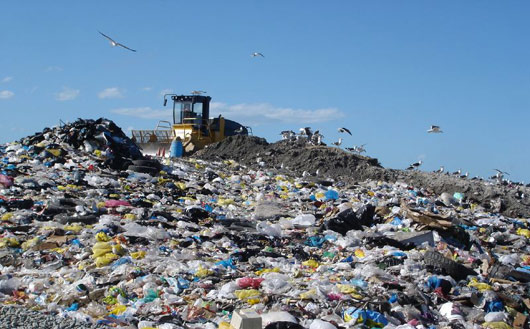
It is a well known secret that plastic hardly breaks down and almost all of the plastic ever made still floats around somewhere. With the great pacific garbage patch now twice the size of Texas and over 500 billion plastic bags produced a year – which take about a 1000 years to decompose – plastic is well on its way of becoming a basic material in the Earths ecosystem.
Earlier, we’ve discussed some of the dramatic effects of this nextnature material and suggested how a future-evolving microbe able to digest plastic, could thrive on the vast amount of plastic ‘food’ available in the biosphere. It might take a million years, however, for such a plastic eating microbe to evolve.
-----
Via NextNature
Monday, November 23. 2009
Demonstrating a CO2 Recycler
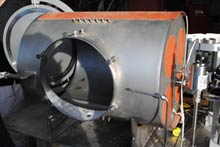 |
| Sun to syngas: This prototype, known as the CR5, was designed by Sandia researchers to convert carbon dioxide into carbon monoxide, or water into hydrogen, using concentrated solar energy. The carbon monoxide and hydrogen can be combined later to produce syngas, a building block for most transportation fuels. The first working prototype, shown above, has demonstrated that the process works, but efforts are underway to make it more efficient. Credit: Tyler Hamilton |
Until recently, the system had only been validated in a laboratory in small batches. A hand-built demonstration machine was successfully tested this fall. "This is a first-of-its-kind prototype we're evaluating," says Sandia researcher Rich Diver, inventor of the device.
"In the short term we see this as an alternative to sequestration," says James Miller, a chemical engineer with Sandia's advanced materials laboratory. Instead of just pumping CO2 underground for permanent storage, Miller says, the sun's abundant energy can be used to achieve "reverse combustion" that essentially turns carbon dioxide back into a fuel. "It's a productive utilization of CO2 that you might capture from a coal plant, a brewery, and similar concentrated sources."
The cylindrical metal machine, called the Counter-Rotating-Ring Receiver Reactor Recuperator (CR5), relies on concentrated solar heat to trigger a thermo-chemical reaction in an iron-rich composite material. The material is designed to give up an oxygen molecule when exposed to extreme heat, and then retrieve an oxygen molecule once it cools down.
The machine is designed with a chamber on each side. One side is hot, the other cool. Running through the center is a set of 14 Frisbee-like rings rotating at one revolution per minute. The outer edge of each ring is made up of an iron oxide composite supported by a zirconium matrix. Scientists use a solar concentrator to heat the inside of one chamber to 1,500 º C, causing the iron oxide on one side of the ring to give up oxygen molecules. As the affected side of the ring rotates to the opposite chamber, it begins to cool down and carbon dioxide is pumped in. This cooling allows the iron oxide to steal back oxygen molecules from the CO₂, leaving behind carbon monoxide. The process is continually repeated, turning an incoming supply of CO2 into an outgoing stream of carbon monoxide.
Miller says the same process can be used to produce hydrogen, the only difference being that water, instead of carbon dioxide, is pumped into the second chamber. The two separately retrieved gases--hydrogen and carbon monoxide--are then mixed together to make syngas, which can be used to make a "drop-in replacement" for traditional fuels, says Miller.
Diver originally designed the machine with the hydrogen economy in mind. The idea was to avoid the inefficiency of electrolysis and build instead a solar heat engine that could produce hydrogen and oxygen directly, cutting out electricity as the middleman. It's an approach also being pursued by researchers in Japan, France, and Germany.
But the Sandia team soon realized that the same process could turn CO2 into carbon monoxide. Even if the hydrogen economy didn't take off, they still had a way to make the fuels we depend on today in a way that limits the impact of burning coal and natural gas for electricity and other industrial processes.
Diver says the challenge now is to improve the efficiency of the system. If the Sandia team can demonstrate higher efficiency, "it could be a significant step forward," said Vladimir Krstic, director of the Centre for Manufacturing of Advanced Ceramics and Nanomaterials at Queen's University in Kingston, Ontario.
Scientists figure it will be 15 to 20 years before the technology is ready for market. In the meantime, the goal is to develop a new generation prototype every three years that shows an increase in solar-to-fuel conversion efficiency and a decrease in cost. Part of that will come from the development of new ceramic composites that release oxygen molecules at lower temperatures, allowing for more of the sun's energy to be converted into hydrogen or carbon monoxide.
"Our short-term goal is to get this to a few percent efficiency," says Miller. "It might seem like a low number, but we like to compare that to photosynthesis, which is actually a very inefficient way to use sunlight."
He says the theoretical maximum efficiency for photosynthesis is around 5 percent, but in the real world it tends to fall to around 1 percent. "So we may be starting very low, but we'd like to keep it in the context of what we have to beat. Ultimately, we believe we have to get in the range of 10 percent sunlight-to-fuels, and we're a long way from doing that."
Copyright Technology Review 2009.
-----
Friday, November 06. 2009
Where plastic ends up
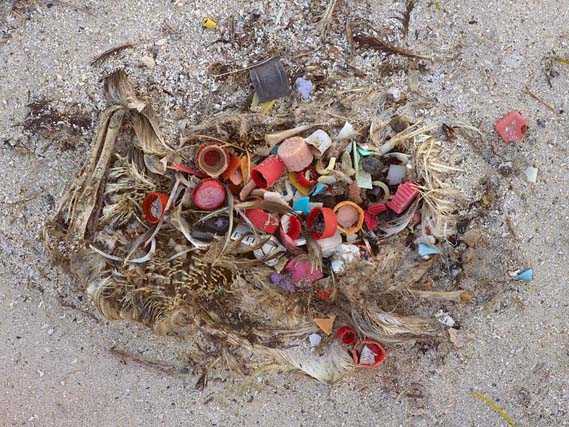
In a shocking series of photographs, Seattle-based Chris Jordan has documented the impact that an abundance of plastic waste in the Pacific ocean has had on the albatross population...
Jordan's latest project, Midway: Message from the Gyre, simply shows a series of dead albatross chicks. But as each decomposes, it offers up a vivid indication of what actually lead to their death: a diet of discarded plastic waste.
As Jordan explains on his site, chrisjordan.com, "These photographs of albatross chicks were made just a few weeks ago on Midway Atoll, a tiny stretch of sand and coral near the middle of the North Pacific. The nesting babies are fed bellies-full of plastic by their parents, who soar out over the vast polluted ocean collecting what looks to them like food to bring back to their young. On this diet of human trash, every year tens of thousands of albatross chicks die on Midway from starvation, toxicity, and choking. To document this phenomenon as faithfully as possible, not a single piece of plastic in any of these photographs was moved, placed, manipulated, arranged, or altered in any way. These images depict the actual stomach contents of baby birds in one of the world's most remote marine sanctuaries, more than 2000 miles from the nearest continent."
The result is some very sad, powerful work.
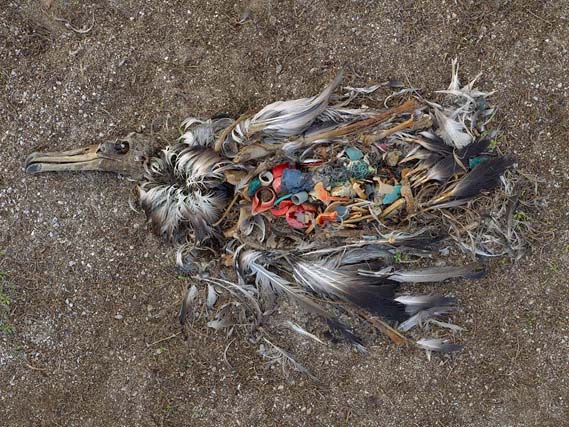
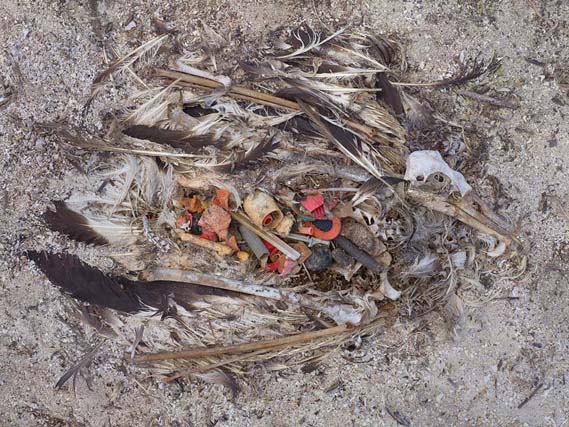
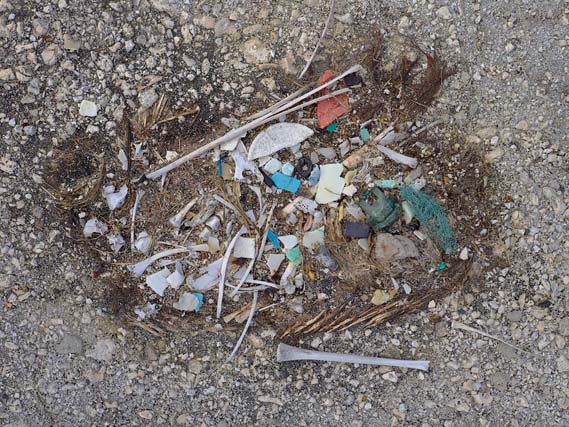
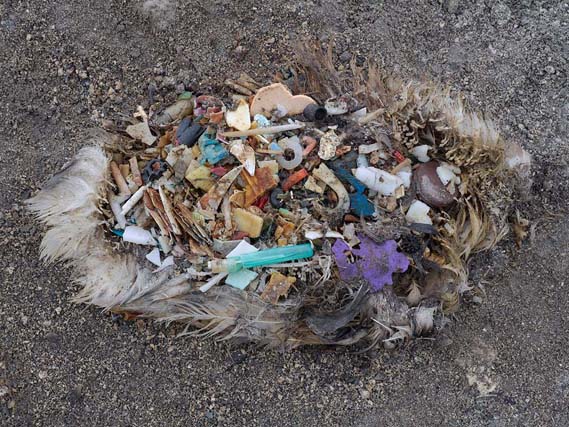

Via The Guardian's Environment page. The rest of the series is on Jordan's site.
-----
Via Creative Review
Monday, May 18. 2009
Sustainable Los Angeles? ...
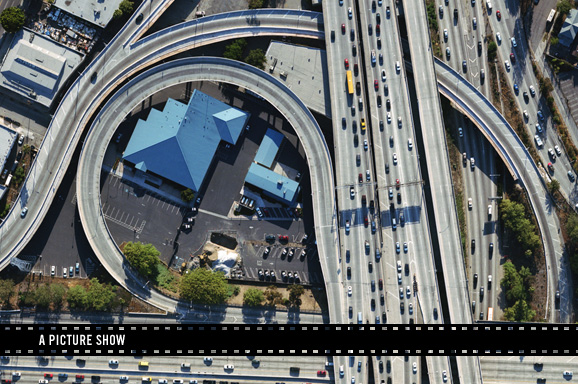
The French writer and philosopher Jean Baudrillard once wrote of the freeways of Los Angeles as being “ideally suited to the only truly profound pleasure, that of keeping on the move.” Indeed, nowhere is the pleasure of keeping on the move more profound than in a city whose freeways rarely offer it.
Rush hour in Los Angeles is synonymous with gridlock, but the sheer enormity of the situation can be tough to grasp. Fortunately, there is the architecture photographer Benny Chan, whose Traffic! series depicts the scale of overcrowded lanes of rush hour traffic from high overhead. Shot over a few years during various helicopter trips, the photographs now stand eight feet high and six feet wide, and convey, quite effectively, the enormity of the problem—as well as the need to get things moving.
Traffic! will show at the Pasadena Museum of California from May 31 through September 20. An opening event will be held on the 30th. What follows is a selection of Mr. Chan’s work. Click each image to (dramatically) enlarge.
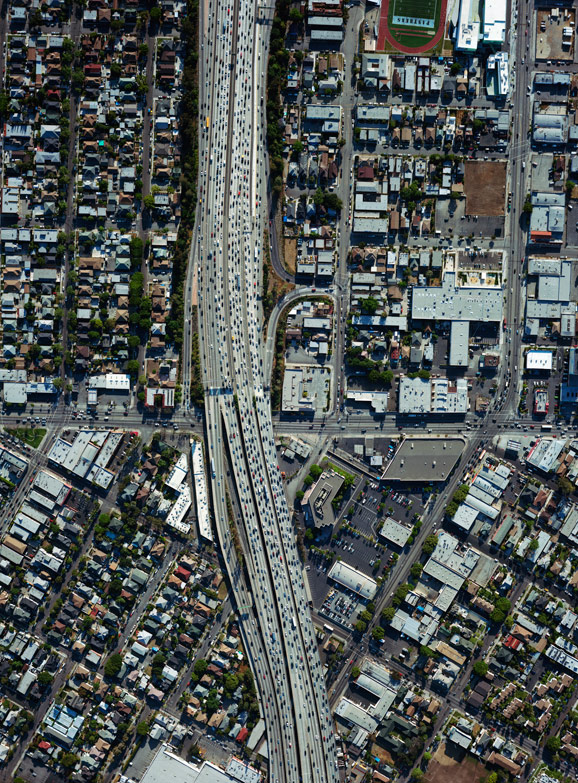
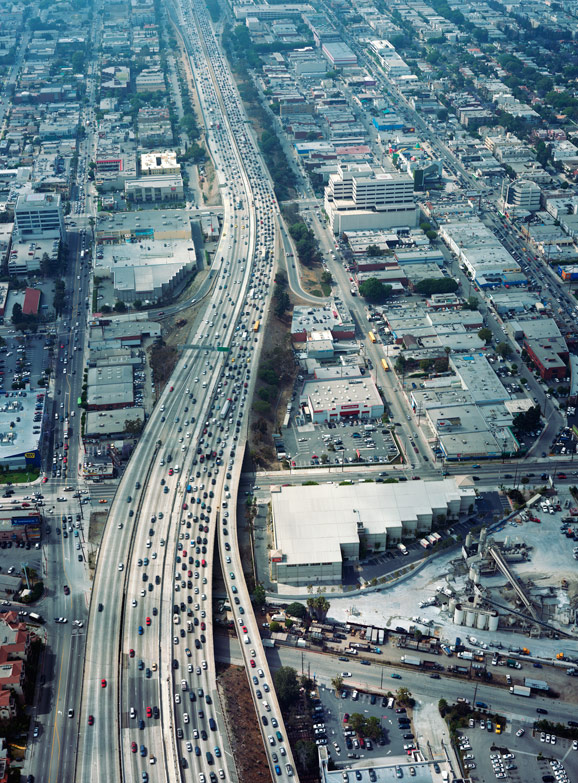
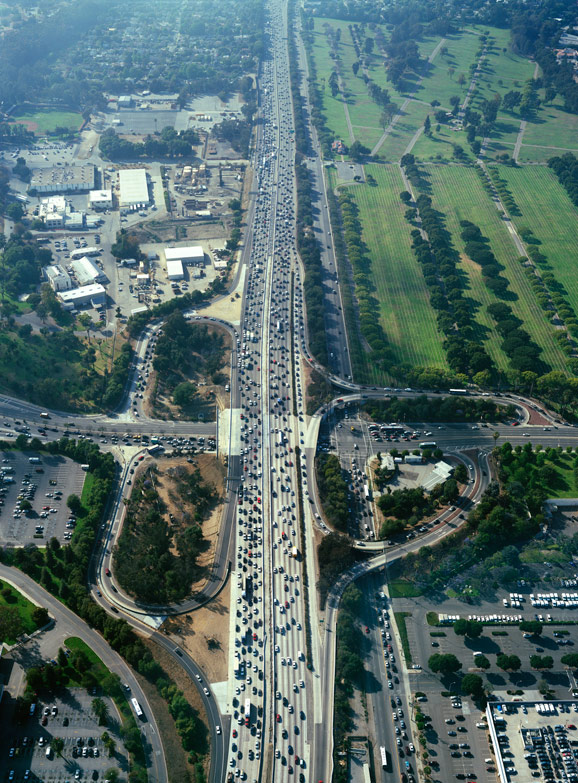
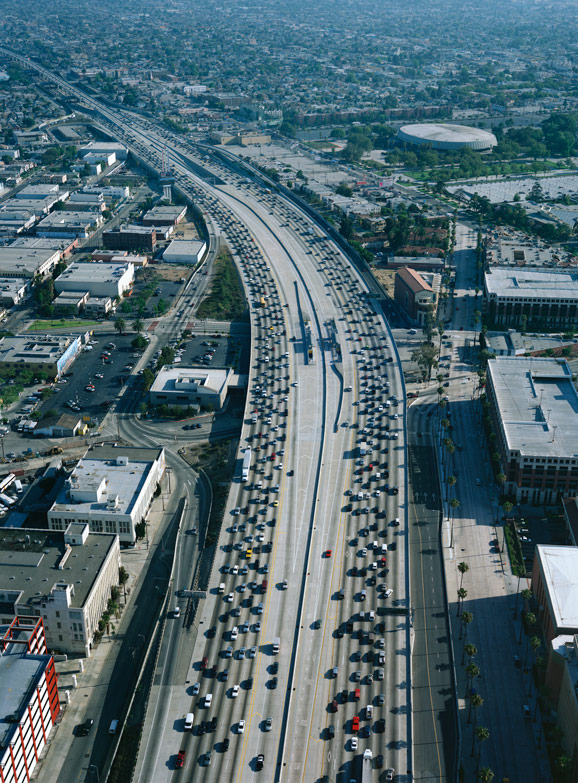
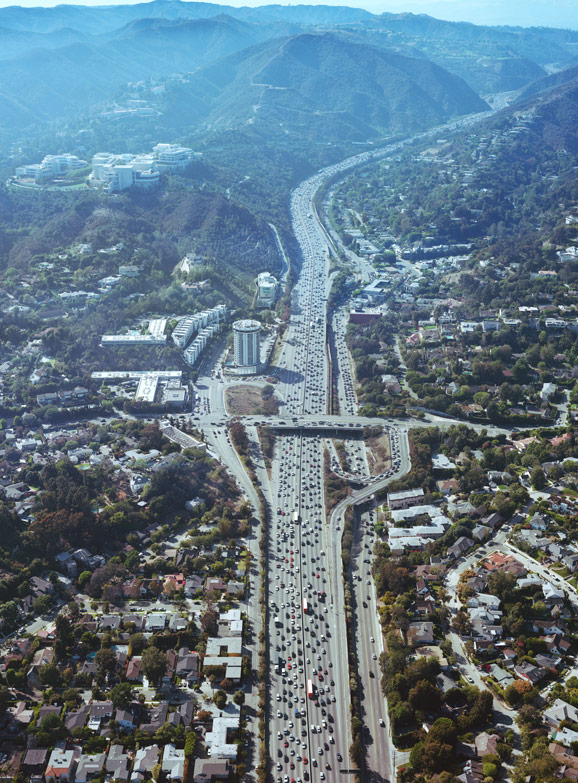
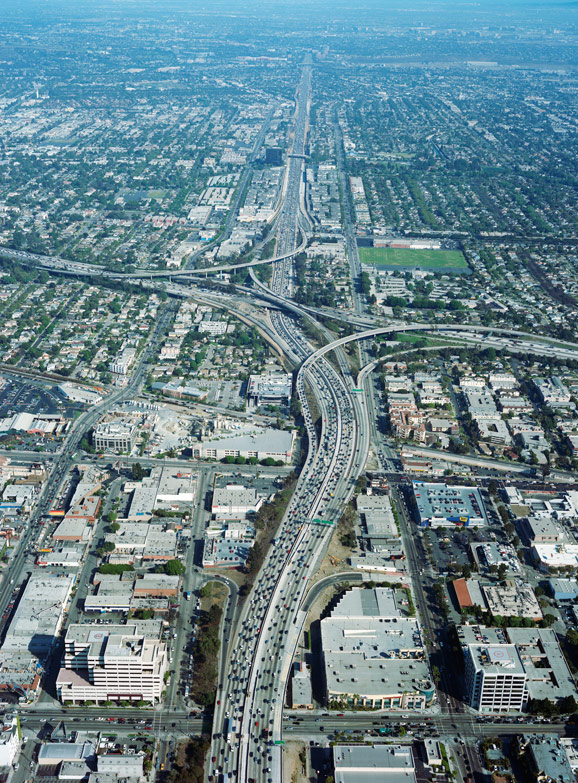
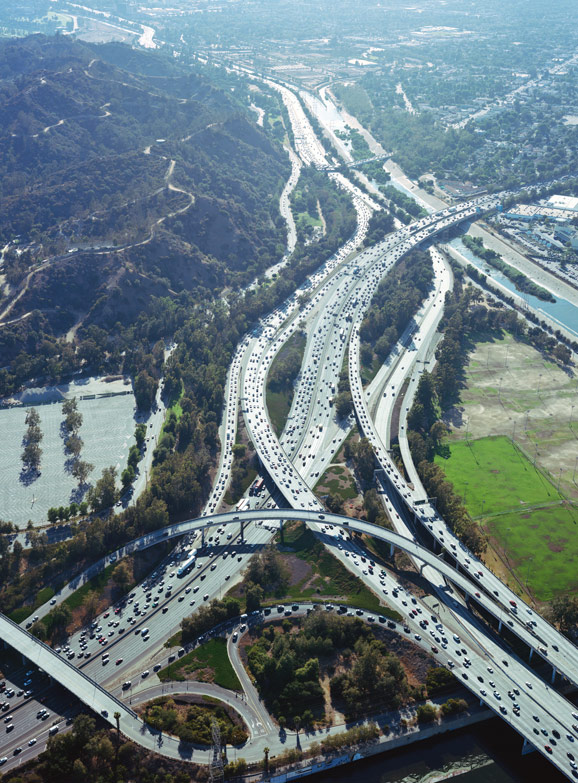
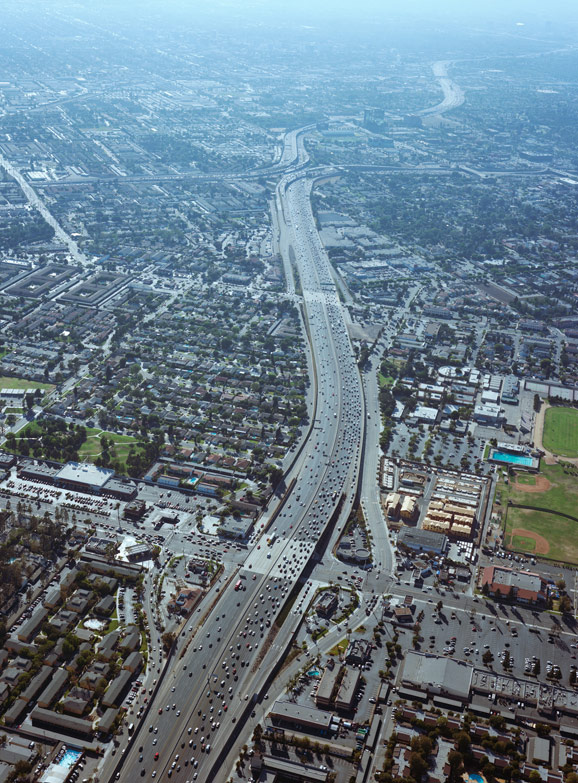
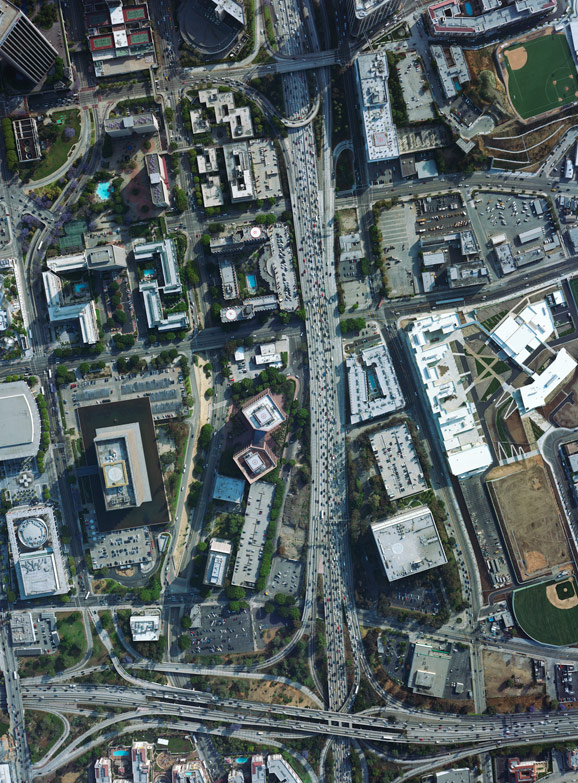
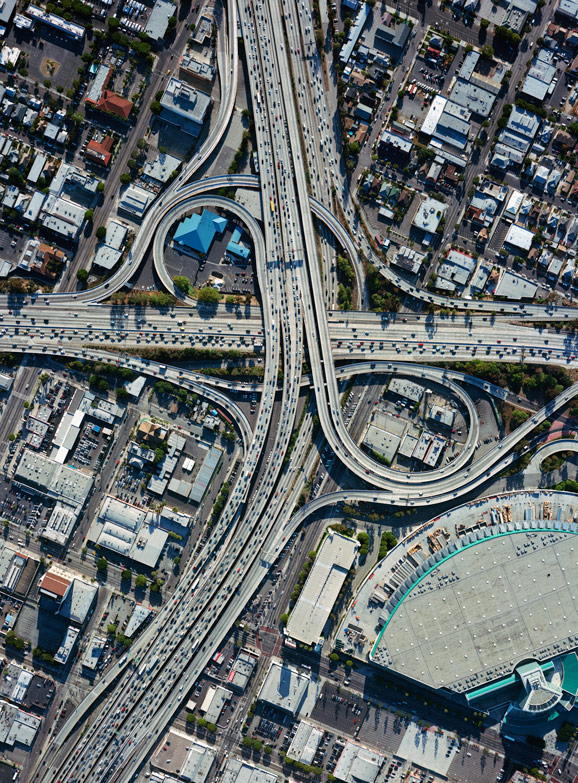
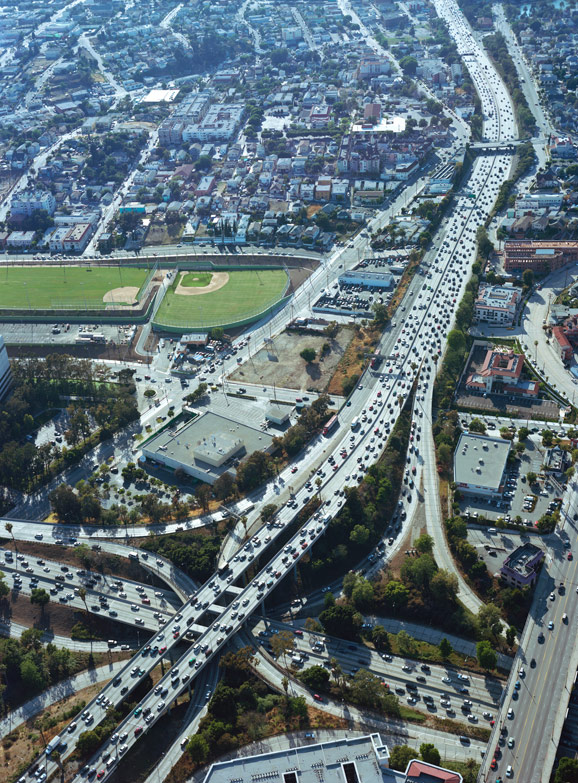
-----
Via Good Magazine
fabric | rblg
This blog is the survey website of fabric | ch - studio for architecture, interaction and research.
We curate and reblog articles, researches, writings, exhibitions and projects that we notice and find interesting during our everyday practice and readings.
Most articles concern the intertwined fields of architecture, territory, art, interaction design, thinking and science. From time to time, we also publish documentation about our own work and research, immersed among these related resources and inspirations.
This website is used by fabric | ch as archive, references and resources. It is shared with all those interested in the same topics as we are, in the hope that they will also find valuable references and content in it.
Quicksearch
Categories
Calendar
|
|
July '25 | |||||
| Mon | Tue | Wed | Thu | Fri | Sat | Sun |
| 1 | 2 | 3 | 4 | 5 | 6 | |
| 7 | 8 | 9 | 10 | 11 | 12 | 13 |
| 14 | 15 | 16 | 17 | 18 | 19 | 20 |
| 21 | 22 | 23 | 24 | 25 | 26 | 27 |
| 28 | 29 | 30 | 31 | |||
